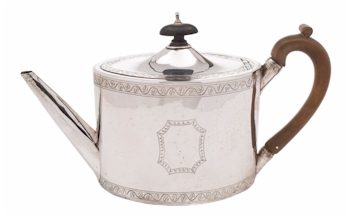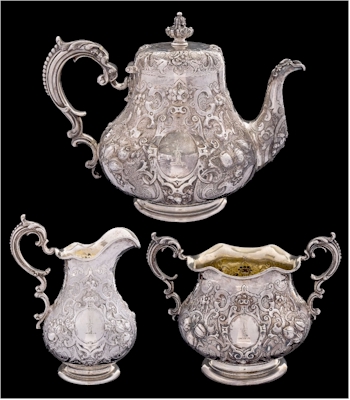
A more traditional late 18th century oval teapot by Henry Chawner, London, 1791 (FS37/309).
What is more quintessentially English than talking about the weather and drinking tea? Although the Chinese have been drinking tea for more than three thousand years, it was only introduced to England in the mid-17th century. It is thought to have first been sold by Thomas Garraway of Exchange Alley, London, in 1657. Indeed, it was the Coffee Houses who were responsible for the introduction of tea to London society. by 1700, it is estimated that over five hundred Coffee Houses sold it.
Tea began to reduce the sale of brandy, ale and gin which led to a reduction in government revenues and, in an attempt to compensate for the loss, they introduced a tea tax. By the mid-18th century, the duty on tea had risen to a whopping 119%. It is no wonder that early teapots were small and tea was locked away in caddies.
As already mentioned, the first teapots were small and sold as individual items. They were normally pear-shaped or ball-shaped, often referred to as bullet-shaped tea pots.

A William IV take on the bullet–shaped teapot, maker Charles Reily & George Storer, London, 1836 (FS40/89).

A modern interpretation on the bullet type teapot, Birmingham, 1960 (FS34/42).
As the price of tea dropped, so the size of teapots grew and the simple ball or pear-shaped designs were superseded by more elaborately decorated teapots.
Sugar was taken in tea from the early 18th century, mostly to mask the bitterness of tea and the wealthy class saw both commodities as luxuries and should be taken together. The expansion of sugar plantations in the Americas and the rising import of both Chinese and later Indian tea meant that tea and sugar were forever linked.
Milk came a little later when black tea became more popular than green tea and by the late 18th century silversmiths were selling three-piece tea sets, which included teapot, sugar basin and milk jug, and sometimes included a coffee pot whose popularity had declined.

Heavy ornamentation on this Victorian silver pear-shaped tea service by Robert Hennell III, London, 1861 (FS41/110).

An ostentatious Victorian silver tea service by John Mappin London, 1888. The height of Victorian elegance (FS42/211).
The taking of tea in the afternoon is believed to have originated with Anna Maria, Duchess of Bedford, the idea being that it would bridge the gap between luncheon and dinner, this resulted in the what we now know as 'High Tea' and would include sandwiches and cake.
By the beginning of the nineteenth century, tea's popularity had reached the working class and it was soon considered an everyday necessity as the price of tea was lower than that of beer. However, it was to the rich and wealthy middle classes that silver tea sets were sold and as the century progressed 'High Tea' especially took on a ritual all of its own with lavishly set tea tables and at the centre the silver tea service. The plain Georgian style of oval or inverted pear-shaped designs were overtaken by more elaborate shapes and what some may call over-elaborate decoration of flowers foliage and fruit.
It is said that the British Empire was built by tea drinkers: well the tea had to be poured out of a teapot, so why not a silver one.

A George V five piece tea and coffee service by William Aitken, Birmingham, 1911 (FS40/33).

Even during the Art deco age there was time for tea (FS28/8).
- Bearnes Hampton & Littlewood
- Silver
Taking Tea was written on Friday, 23rd August 2019.











